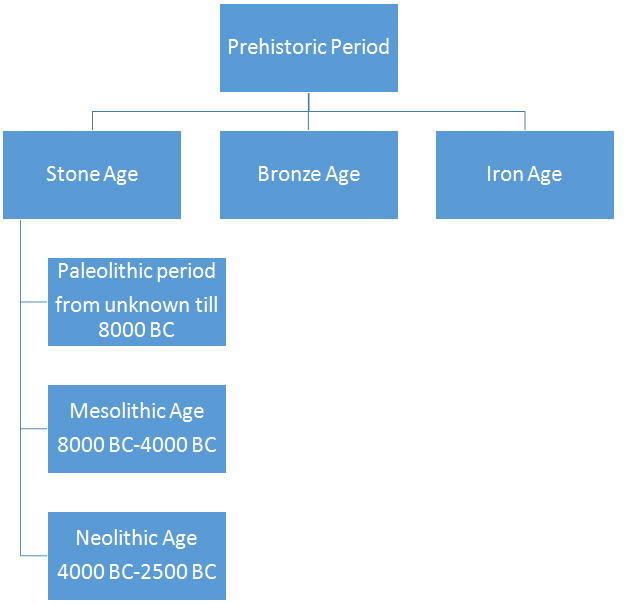
Pre – Historic Period Of India
The Prehistoric Period
The prehistoric period in the history of mankind can roughly be dated from 200000 BC to about 3500-2500 BC, when the first civilizations began to take shape. The history of India is no exception. The first modern human beings or the Homo sapiens set foot on the Indian subcontinent anywhere between 200000 BC and 40000 BC and they soon spread throughout a large part of the subcontinent, including peninsular India.. These primitive people moved in groups of few ‘families’ and lived mainly on hunting and gathering
Stone Age
The age when the prehistoric man began to use stones for utilitarian purpose is termed as the Stone Age. The Stone Age is divided into three broad divisions —
Paleolithic Age or the Old Stone Age (from unknown till 8000 BC),
Mesolithic Age or the Middle Stone Age (8000 BC-4000 BC) and
the Neolithic Age or the New Stone Age (4000 BC-2500 BC)
on the basis of the specialization of the stone tools, which were made during that time.
Paleolithic Age – from unknown till 8000 BC
The human beings living in the Paleolithic Age were essentially food gatherers and depended on nature for food. The art of hunting and stalking wild animals individually and later in groups led to these people making stone weapons and tools.
These kind of tools were generally used to kill small animals and for tearing flesh from the carcass of the hunted animals. The basic technique of making these crude tools was by taking a stone and flaking its sides with a heavier stone. These tools were characteristic of the Paleolithic Age and were very rough. By this time, human beings had come to make and use fire.
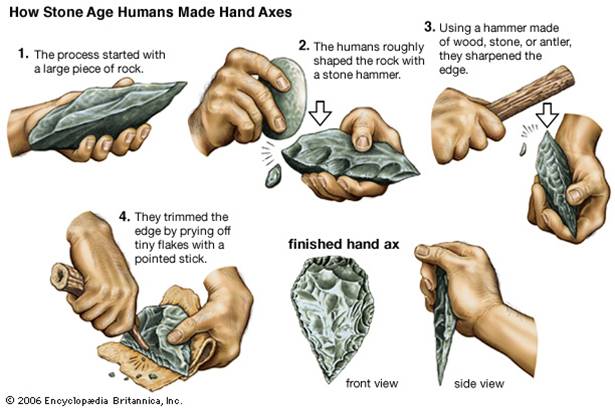
Pre – Historic Period Of India
Mesolithic Age – 8000 BC-4000 BC
In the Mesolithic Age, the stone tools began to be made more pointed and sharp. To ensure a life that had abundance of food and clothing, the stone tools began to appear in increasingly specialized way.
The simple handheld stone tools were now attached to thick branches from trees with rope made from animal skin and sinew. These tools are known as hand axes, which could be flung at fast-moving animals from a distance.
Apart from hand axes, they also produced crude stone-tipped wooden spears, borers, and burins
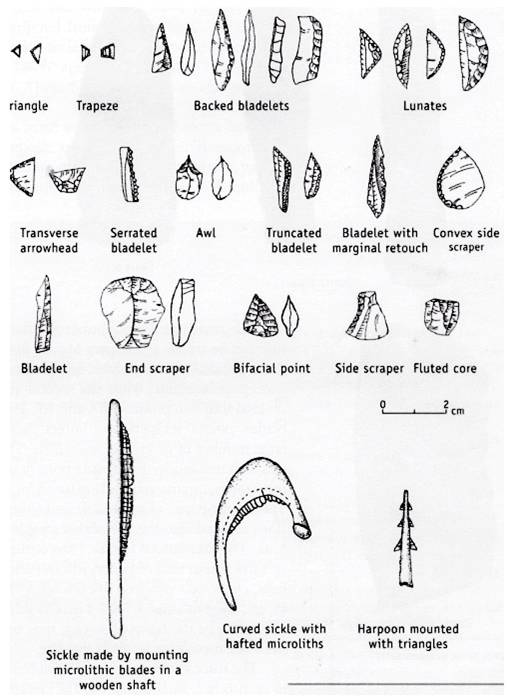
Pre – Historic Period Of India
This period also saw the domestication of animals and graving of wild varieties of crops. Because of farming, small settlements began to take shape.
The famous Bhimbetka caves near Bhopal belong to the Mesolithic Age and are famous for their cave paintings. The exact date of these paintings is not certain, but some of the paintings are as old as 12,000 years. The prehistoric artist used natural white and red pigments in depicting the various themes, which were close to his heart and sustenance
Mesolithic site – Bhimbhetka , Bhopal , M.P
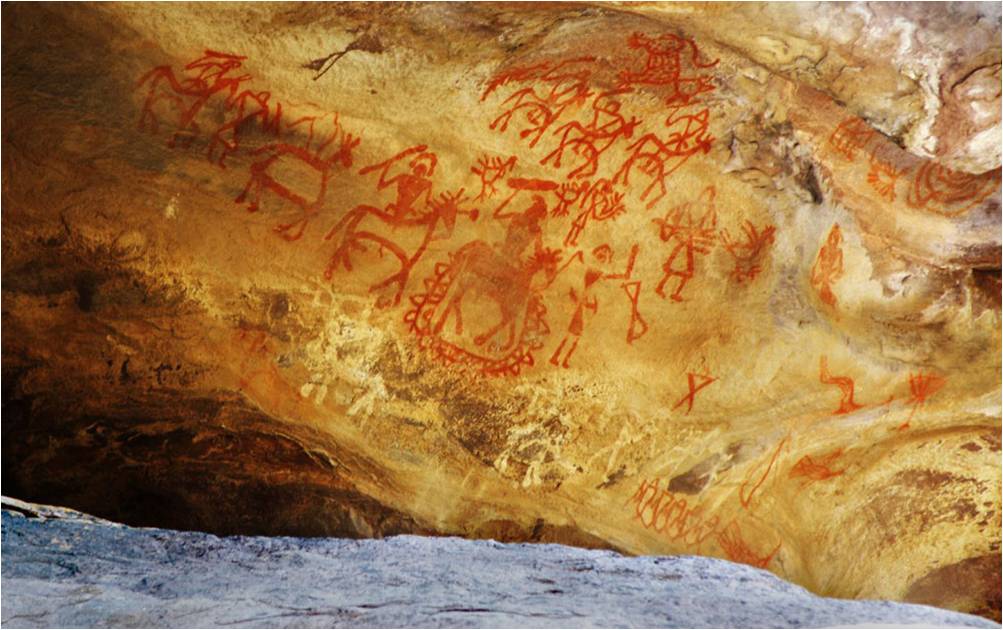
Neolithic Age – 4000 BC-2500 BC
The Neolithic Age (4000 BC-2500 BC) or the New Stone Age was the last phase of the Stone Age and is characterized by very finely flaked, small stone tools, also known as blades and burins.
The Neolithic Age also saw the domestication of cattle, horses, and other farm animals. which were used for dairy and meat products. An important invention of this time was the making of the wheel.
Stone Tools: There was a great improvement in the technology of making tools. They used polished stone tools and axes for gathering and hunting.
Houses: Houses built of mudbricks instead of grass huts.
Pottery: Utensils made on wheels used for cooking and storing food grains.
Burials: Neolithic people buried dead in coffins (large urns)
Agriculture: Above all, there was an improvement in agriculture. Neolithic people cultivated wheat, barley, rice, millet.
Domestication: People domesticated sheep, goats, and cattle. Furthermore, they used cattle for cultivation and transport. Likewise, the people of the Neolithic Age used clothes made of cotton and wool.
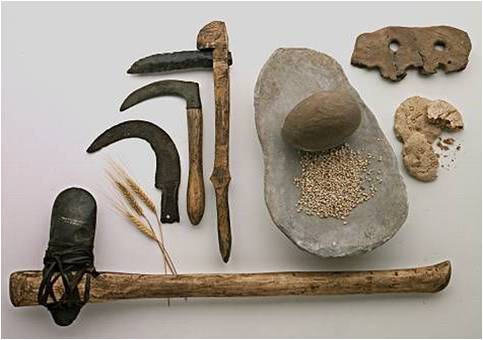
Pre – Historic Period Of India
Chalcolithic Phase
The end of the Neolithic period saw the use of metals. Several cultures were based on the use of copper and stone implements.
Such a culture is called Chalcolithic and as the name indicates, during the Chalcolithic (Chalco = Copper and Lithic = Stone) period, both metal and stone were utilised for the manufacture of the equipment in day-to-day life.
The Chalcolithic cultures followed the Bronze Age Harappa culture.
It spanned around2500 BC to 700 BC
The Chalcolithic culture of a region was defined according to certain salient features seen in ceramics and other cultural equipment like copper artefacts, beads of semi-precious stones, stone tools and terracotta figurines.
First Metal Age of India:
Since this was the first metal age, copper and its alloy bronze which melt at low temperature were used for the manufacture of various objects during this period.
Art and Craft:
Thespecialty of the Chalcolithic culture was wheel made pottery mostly of red and orange colour.
Different types of pottery were used by the people of the Chalcolithic phase. The Black-and-Red pottery among them was quite common.
The Ochre-Coloured Pottery(OCP)was also in use.
Excavation at Eran during 2020-21
Eran (ancient Airikina) is situated on the left bank of the Bina (ancient Venva)river and surrounded by it on three sides.
Bina riveris a river that flows in Madhya Pradesh state of India. It is a chief tributary of the Betwa river,which is itself a tributary of the Yamuna river.
Eran is located 75 km north-west from Sagar district headquarter.
The recent excavation at this site, during 2020-21, has unearthed a variety of antiquities including a copper coin, an iron arrowhead, terracotta bead, stone beads along with a copper coins, stone celt, beads of steatite and jasper, glass, carnelian, terracotta wheel, animal figurines, miniature pots, iron objects, stone querns, pestles and a red slipped terracottawith inscription in Devnagari.
Excavation at Tewar during 2020-21
Tewar (Tripuri) village is located 12 km west of Jabalpur district on Jabalpur – Bhopal highway
Antiquarian remains in this excavation include viz remains of sculptures, hopscotch, terracotta balls, Iron nails, copper coins, terracotta beads, implements of Iron and terracotta figurine, in ceramics red ware, black ware, red slipped ware with shapes of handi, bowl, spouted pot, small pot, big jar, etc., structural remains consist of brick wall and structure of sandstone columns.
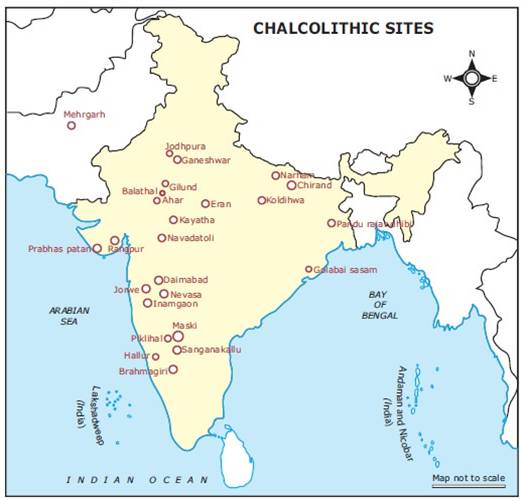








No comment